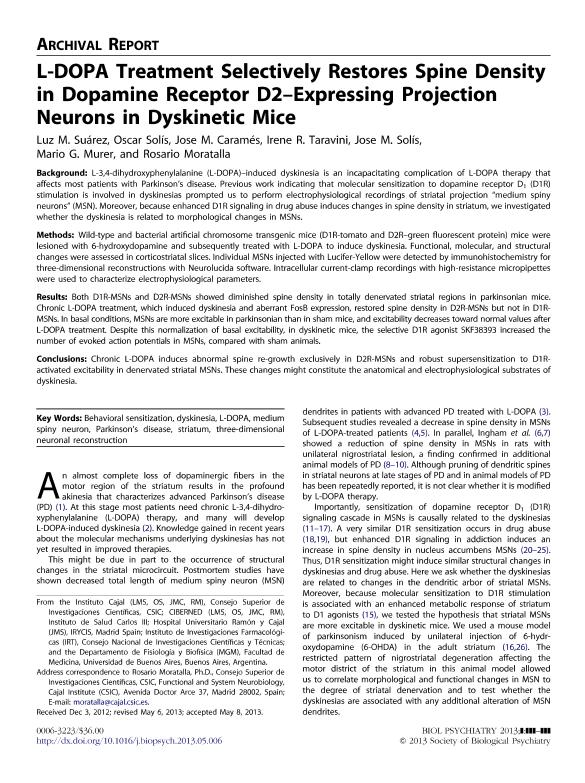Artículo
L-DOPA treatment selectively restores spine density in dopamine receptor d2-expressing projection neurons in dyskinetic mice
Suárez, Luz M.; Solís, Oscar; Caramés, Jose M.; Taravini, Irene Rita Eloisa ; Solís, Jose M.; Murer, Mario Gustavo
; Solís, Jose M.; Murer, Mario Gustavo ; Moratalla, Rosario
; Moratalla, Rosario
 ; Solís, Jose M.; Murer, Mario Gustavo
; Solís, Jose M.; Murer, Mario Gustavo ; Moratalla, Rosario
; Moratalla, Rosario
Fecha de publicación:
05/2014
Editorial:
Elsevier
Revista:
Biological Psychiatry
ISSN:
0006-3223
Idioma:
Inglés
Tipo de recurso:
Artículo publicado
Clasificación temática:
Resumen
Background: L-3,4-dihydroxyphenylalanine (L-DOPA)–induced dyskinesia is an incapacitating complication of L-DOPA therapy that affects most patients with Parkinson’s disease. Previous work indicating that molecular sensitization to dopamine receptor D1 (D1R) stimulation is involved in dyskinesias prompted us to perform electrophysiological recordings of striatal projection “medium spiny neurons” (MSN). Moreover, because enhanced D1R signaling in drug abuse induces changes in spine density in striatum, we investigated whether the dyskinesia is related to morphological changes in MSNs. Methods: Wild-type and bacterial artificial chromosome transgenic mice (D1R-tomato and D2R–green fluorescent protein) mice were lesioned with 6-hydroxydopamine and subsequently treated with L-DOPA to induce dyskinesia. Functional, molecular, and structural changes were assessed in corticostriatal slices. Individual MSNs injected with Lucifer-Yellow were detected by immunohistochemistry for three-dimensional reconstructions with Neurolucida software. Intracellular current-clamp recordings with high-resistance micropipettes were used to characterize electrophysiological parameters. Results: Both D1R-MSNs and D2R-MSNs showed diminished spine density in totally denervated striatal regions in parkinsonian mice. Chronic L-DOPA treatment, which induced dyskinesia and aberrant FosB expression, restored spine density in D2R-MSNs but not in D1R-MSNs. In basal conditions, MSNs are more excitable in parkinsonian than in sham mice, and excitability decreases toward normal values after L-DOPA treatment. Despite this normalization of basal excitability, in dyskinetic mice, the selective D1R agonist SKF38393 increased the number of evoked action potentials in MSNs, compared with sham animals. Conclusions: Chronic L-DOPA induces abnormal spine re-growth exclusively in D2R-MSNs and robust supersensitization to D1R-activated excitability in denervated striatal MSNs. These changes might constitute the anatomical and electrophysiological substrates of dyskinesia.
Archivos asociados
Licencia
Identificadores
Colecciones
Articulos(ININFA)
Articulos de INST.DE INVEST.FARMACOLOGICAS (I)
Articulos de INST.DE INVEST.FARMACOLOGICAS (I)
Citación
Suárez, Luz M.; Solís, Oscar; Caramés, Jose M.; Taravini, Irene Rita Eloisa; Solís, Jose M.; et al.; L-DOPA treatment selectively restores spine density in dopamine receptor d2-expressing projection neurons in dyskinetic mice; Elsevier; Biological Psychiatry; 75; 9; 5-2014; 711-722
Compartir
Altmétricas



